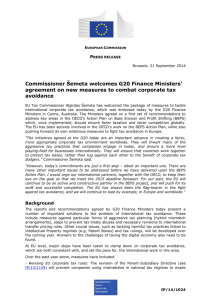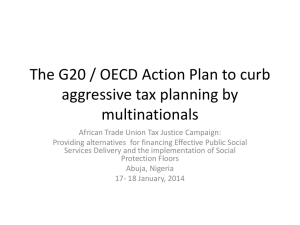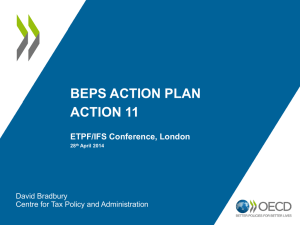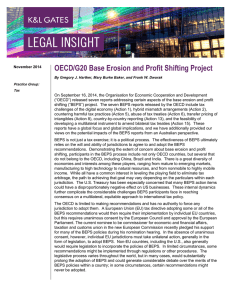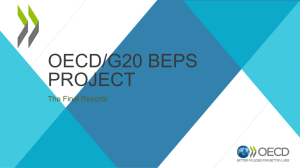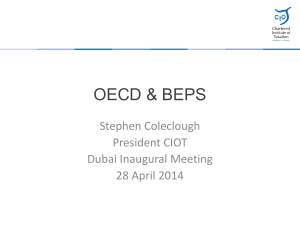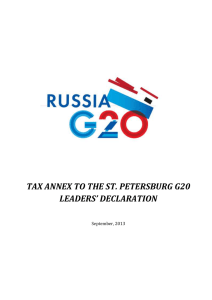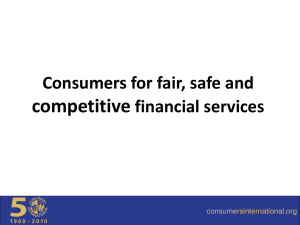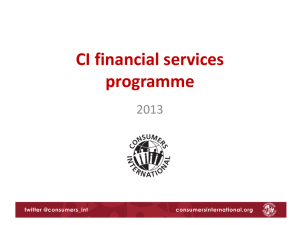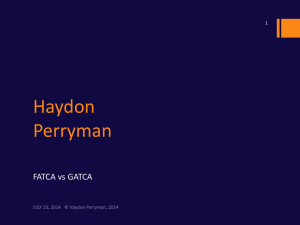BEPS and Automatic Exchange of Information
advertisement
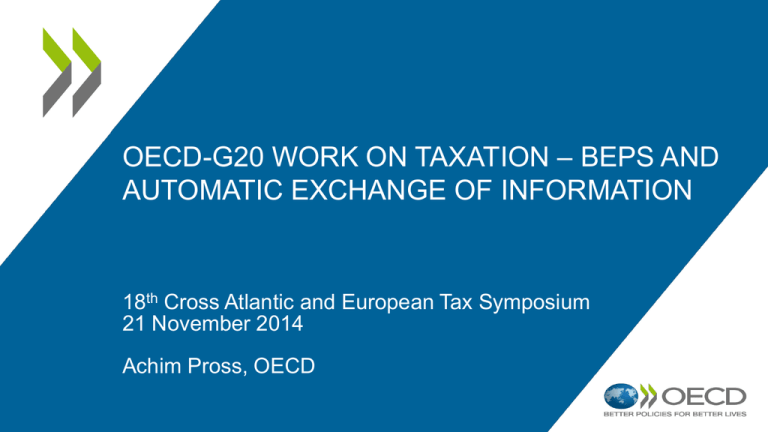
OECD-G20 WORK ON TAXATION – BEPS AND AUTOMATIC EXCHANGE OF INFORMATION 18th Cross Atlantic and European Tax Symposium 21 November 2014 Achim Pross, OECD Outline BEPS • Background and context • OECD BEPS Report • Action Plan against BEPS • The 2014 Deliverables • Next steps Automatic Exchange of Information • Background, context and timeline • The Standard: basic approach and key features • Next steps 2 BASE EROSION AND PROFIT SHIFTING 3 Background and context • Tax rates on foreign income – often very low / issue of double non-taxation; • Separation of place of economic activity and place where profits are reported for tax purposes; • Increasing importance of intangible assets; • Principles of international taxation often developed in the 1920s: – Less cross-border activity; – Changes to business models, e.g. globalisation of value chains, „digital economy“; – Built on the assumption that profits are taxed in the other country. 4 Background and context (cont.) • Doing nothing is not an option: ─ ─ ─ ─ Increased possibilities for mismatches; Increased competitive distortions; Additional disputes and increased uncertainties for business; Use of anti-avoidance measures may decide who will grab a part of the taxable income (“First in time, first in line.”); ─ Tax rates → Race to the bottom; ─ Danger of undermining voluntary compliance by other taxpayers. • No blaming / no finger-pointing: – Not about blaming business; if we want different results we need to look again at the system – And not about blaming particular countries either. 5 OECD BEPS Project to date • Step 1: Addressing BEPS (February 2013): – Identifies main pressure areas leading to opportunities for BEPS – Calls on governments to address these areas: if governments are not happy with the results under the laws, they must change the laws. – Welcomed by G20 Finance Ministers (16 February 2013) • Step 2: BEPS Action Plan (July 2013): – 15 actions to be delivered in 2014 and 2015 based on coherence, substance and transparency – Endorsed by G20 Leaders (6 September 2013) • Step 3: First Seven Deliverables – September 16,2014, release of first seven deliverables, agreed by consensus by all OECD and G20 countries – Welcomed by G20 Finance Ministers (21 September 2014) 6 Key pressure areas Hybrid Mismatch Arrangements Availibility of preferential regimes Group financing Treaty abuse, Anti-avoidance measures, etc. Transfer pricing Delivery of digital goods and services Intangibles Financing 7 Overview all actions September 2014 Digital Economy Report Hybrids Review of HTP Regimes Preventing Treaty Abuse Addressing TP aspects of Intangibles (Phase 1) Addressing TP documentation Multilateral Instrument Report September 2015 CFC Rules Interest Deductibility Strategy on expansion of FHTP Addressing avoidance of PE status Addressing TP aspects of Intangibles (Phase 2) Addressing TP aspects of risks and capital Addressing TP aspects of other high risk transactions Report on Data and Economic Analyses Mandatory Disclosure Rules Dispute Resolution December 2015 Addressing TP Interest Deductions Revision of HTP Criteria Multilateral Instrument 8 46 countries involved Iceland Canada USA Mexico Chile Austria Belgium Czech Republic Denmark Estonia Finland France Germany Greece Hungary Ireland Israel Italy Latvia Luxembourg Netherlands Norway Poland Portugal Slovak Republic Slovenia Spain Sweden Switzerland Turkey United Kingdom Russia Saudi Arabia India Colombia China Japan Korea Malaysia Singapore Indonesia Brazil Australia Chile Argentina South Africa New Zealand 9 THE 2014 DELIVERABLES 10 The 2014 Deliverables • Explanatory Statement • 3 Reports: – two final reports on the Digital Economy (Action 1) and the Feasibility of a Multilateral Instrument (Action 15) – one interim report on harmful tax practices (Action 5) • Draft Rules in 4 areas – – – – Hybrid mismatch arrangements Treaty abuse TP Intangibles TP Documentation and CBC template 11 Action 1 – Digital economy - key outcomes • • • • • Common understanding of digital economy, its business models and aspects relevant for taxation Digital economy can not be segregated from wider economy Does not raise unique BEPS issues, but some of its key features (especially mobility) may exacerbate BEPS risks. These features need to be taken into account in other work in BEPS, e.g. (i) artificial avoidance of PE, (ii) CFC rules, and (iii) Transfer pricing and value creation Digital economy also raises broader challenges for direct tax (related to nexus, characterisation, and data which may overlap), and indirect tax (related to VAT collection for cross-border business-to-consumer transactions) Task Force discussed potential options and agreed on framework for evaluation, but concluded that the fact that other work to address BEPS is ongoing makes the scope of challenges and impact of options difficult to evaluate 12 Action 1 – Digital economy - key outcomes • Work continues in order to: – Address collection of VAT in B2C transactions – Ensure that work in other areas of BEPS addresses BEPS in the digital economy – Address broader tax challenges, refine potential options, and evaluate impact of BEPS work – Consider economic incidence of VAT and CIT and impact on broader options – If further actions are necessary to address BEPS in digital economy, consider limiting application of options for broader tax challenges to situations in which BEPS concerns arise • Work will be completed by December 2015 13 Action 2 – Hybrid mismatches • What is a hybrid mismatch arrangement? – An arrangement that exploits the different tax treatment in two jurisdictions to produce a mismatch in tax outcomes – Mismatch is either two deductions for the same payment or a deductible payment that is not included in income by the recipient • What are we trying to achieve? – Recommendations for domestic law changes and changes to OECD Model Convention to deal with hybrids. – Clear, automatic and comprehensive rules that neutralise the tax mismatch without disturbing the commercial or regulatory consequences. 14 Action 2 – Overview of key features Linking rules Rule order Scope DN/I Instruments / entities Indirect DN/I Instruments / entities DD Entities only Special rule on dividend exemption for instruments General rule: deny deduction Primary rule & defensive rule. Controlled groups and structured arrangements. Related parties for instruments. 15 Action 2 – Where have we got to? • We have consensus on: - Linking rules as a concept and their detailed application. Scope to ensure rules are comprehensive but still administrable by taxpayers and tax administrations. Rules that neutralise hybrid mismatches even if counterparty jurisdiction does not have them. Rules that ensure application does not lead to double taxation. • Rules both reduce transaction costs and tax risks for cross-border investment when compared with uncoordinated action. • Ongoing work to ensure co-ordination with other Actions • Commitment to a second phase of work with a focus on implementation issues. 16 Action 5 – Harmful tax practices • 2014 Progress report – Update on work on substantial activity as it would apply to IP regimes – Framework for exchanging information on taxpayer specific rulings – List of member and associate regimes under review • Next steps: – Finalise agreement on an approach to substantial activity for IP regimes in particular in light of joint UK-German proposal – Agree how to apply elaborated substantial activity criteria to other, non IP, regimes – Apply framework on rulings and start to exchange information – Engage with third countries (i.e. non-OECD/G20) on participation in FHTP – Consider revisions or amendments to the existing criteria 17 Action 6 – Treaty abuse • Agreement that treaties not to be used to generate double non-taxation • Agreement on a common minimum standard to tackle treaty abuse • Further work to be done on some technical details related to the drafting of the provisions • Further work to consider impact of anti-abuse provisions on collective investment vehicles. 18 Action 8 – Intangibles • A broad definition of intangibles is introduced • Important value creating activities relating to intangibles will get appropriate remuneration • If no comparables exist, techniques to value are available • Benefits following from corporate synergies cannot be centralised in low tax locations, but must be shared among the group members which contribute to these synergies • Guidance on locational advantages • Many examples • Artificial profit shifting to “cash boxes” no longer tolerated • Some guidance interim since issues are closely related to 2015 work on treatment of risks, capital, and recharacterisation 19 Action 13 – Transfer pricing documentation • Agreement on standard TP documentation that includes Master file, local file and country-by-country reporting template • Overview of where profits, sales, employees, and assets are located and where taxes are paid and accrued on a country-by-country basis • Useful tool for risk assessment • Work ongoing on scope and filing mechanism to be completed early 2015 • Post implementation review by 2020 20 Action 13 – Model Template of CbC report 21 Action 13 – Model Template of CbC report (cont.) 22 Action 15 – Multilateral Instrument • Based on precedents from various areas other than tax, a multilateral instrument to implement BEPS measures is feasible • It is also desirable to ensure the sustainability of the consensual framework to eliminate double taxation • Goal is to expedite and streamline the implementation of the measures developed to address BEPS • Report recommends a multilateral instrument to be developed soon and to cover at least tax treaty related BEPS measures 23 Next steps • All recommendations are agreed but will remain in draft form so that the potential impact of the 2015 deliverables can be incorporated before finalising them. • Implementation and practical guidance will be developed. • The next outputs of the BEPS Project are due to be delivered in September and December 2015. 24 STANDARD FOR AUTOMATIC EXCHANGE OF FINANCIAL ACCOUNT INFORMATION 25 The OECD-Standard on Automatic Exchange of Information G20 Summit, St Petersburg Sep ‘13 Support to OECD/G20 work on: - Presenting standard by February 2014; and - Finalizing technical modalities by mid-2014. Next slide Asked the GFTEI to establish mechanism to monitor and review implementation of standard. Called on the OECD, the GFTEI and others to ensure developing countries can benefit from new standard (technical assistance). 26 The OECD-Standard on Automatic Exchange of Information • February 2014: G20 endorsement of the Common Reporting Standard for automatic exchange of tax information • September 2014: G20 endorsement of the full standard and commitment to begin exchanging information by 2017 or end-2018 • November 2014: Presentation to G20 Leaders 27 35 years of automatic exchange in 3 slides The first 20 years ‘81 ‘92 Design of the Paper Standard Format Standard Magnetic Format (SMF) adopted ‘03 ‘05 Approval of EU Savings Directive which builds upon SMF ‘10 US enacts FATCA Standard Transmission Format (STF) adopted EU Savings Directive updates to STF 28 35 years of automatic exchange in 3 slides The transition Jun ‘12 Jul ‘12 Nov ‘12 Apr ‘13 FATCA Model 1 IGA includes commitment to develop a common model In Los Cabos, G20 welcomes OECD report on AEOI G20 Support AEOI G5 pilot (early adopters) 29 35 years of automatic exchange in 3 slides Design and implementation of the CRS Jun ‘13 Sep ‘13 Nov ‘13 Jan ‘14 Dec ‘13 Mar ‘14 Feb ‘14 G20 endorse European AEOI as new Council global commits to standard and adopt DAC2 ask OECD to in 2014 develop CRS Early adopters statement (44 countries) G20 endorse CRS OECD report to G8 on common model for AEOI GFTEI creates AEOI group May ‘14 OECD approves first part of standard Jun ‘14 Jul ‘14 Sep ‘14 Oct ‘14 Oct ‘14 Nov ‘14 OECD Full version of GF Berlin: 93 jurisdictions approves full standard commit to version of endorsed by AEOI standard G20 Ministers OECD Ministerial Declaration (OECD Members + 14 other countries, including Singapore) OECD Council Recommend. on AEOI CAA signed by 51 jurisdictions Ecofin political agreement on revised DAC2 which incorporates CRS Ongoing business consultation 2017 First exchange under CRS Full version of Standard presented to G20 Leaders together with overview of committed countries 30 Jurisdictions committed to AEOI 2017 2018 31 Automatic exchange standard Basic approach: Leveraging on FATCA Account Holder Bank Country A 1. Model 1 IGA reporting 2. Model 1 IGA exchanges 3. Leveraging on Model 1 IGA implementation to develop standardised automatic exchange in a multilateral context US Bank Account Holder Country B Account Holder Bank 32 AEOI standard: Building on FATCA, EU Savings Directive and FATF to have Single Standard and Reduce Cost Similar scope of information reported • Personal data: name, address, tax residence, TIN • Financial data: account balance, investment income, sales proceeds from financial assets Similar scope of financial institutions required to report • Banks, custodians, insurance companies and investment entities (e.g. certain collective investment vehicles) Similar scope of account holders subject to reporting • Individuals • Entities (including trusts and foundations) • Controlling persons (i.e., beneficial owners) of entities Similar Due diligence procedures • Distinction pre-existing /new, individual/entity, lower value/high value accounts 33 Next Steps Country implementation • • • • • • Translating the reporting and due diligence rules into domestic law Selecting a legal basis for the exchange of information Entering into Competent Authority Agreements Protecting confidentiality and safeguarding data Making effective use of the information Putting in place the related administrative resources and required IT infrastructure • Developing secure, effective and common transmission systems • Measuring impact • Voluntary disclosure initiatives 34 Next steps for OECD • Ongoing maintenance to resolve issues and ensure consistency (in consultation with FIs) • Produce training material (CRS Implementation Handbook) and co-host training events for implementing countries (together with Global Forum) • CRS portal for both general and country-specific information on implementing the Standard (including information on TINs and residence rules) • Continued support to “operationalise” Multilateral CAA • Voluntary disclosure • Toolbox for making effective use of information • Alignment of TRACE to CRS and assist in country implementation 35 OECD-G20 work on taxation – BEPS and Automatic Exchange of Information Questions and comments: Achim.PROSS@oecd.org 36
